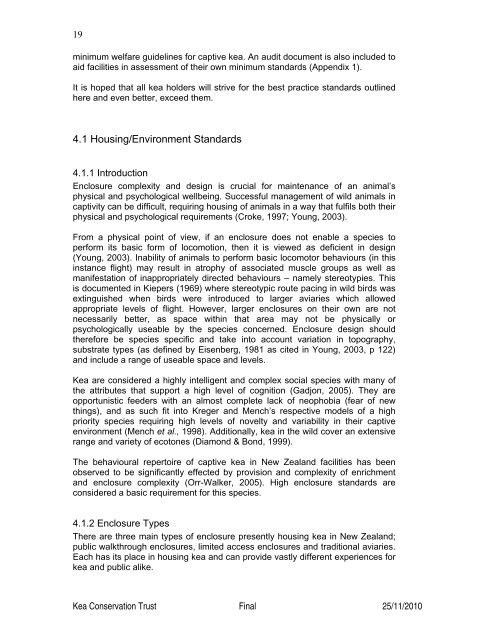(Nestor notabilis) Husbandry Manual - Kea Conservation Trust
(Nestor notabilis) Husbandry Manual - Kea Conservation Trust
(Nestor notabilis) Husbandry Manual - Kea Conservation Trust
Create successful ePaper yourself
Turn your PDF publications into a flip-book with our unique Google optimized e-Paper software.
19<br />
minimum welfare guidelines for captive kea. An audit document is also included to<br />
aid facilities in assessment of their own minimum standards (Appendix 1).<br />
It is hoped that all kea holders will strive for the best practice standards outlined<br />
here and even better, exceed them.<br />
4.1 Housing/Environment Standards<br />
4.1.1 Introduction<br />
Enclosure complexity and design is crucial for maintenance of an animal’s<br />
physical and psychological wellbeing. Successful management of wild animals in<br />
captivity can be difficult, requiring housing of animals in a way that fulfils both their<br />
physical and psychological requirements (Croke, 1997; Young, 2003).<br />
From a physical point of view, if an enclosure does not enable a species to<br />
perform its basic form of locomotion, then it is viewed as deficient in design<br />
(Young, 2003). Inability of animals to perform basic locomotor behaviours (in this<br />
instance flight) may result in atrophy of associated muscle groups as well as<br />
manifestation of inappropriately directed behaviours – namely stereotypies. This<br />
is documented in Kiepers (1969) where stereotypic route pacing in wild birds was<br />
extinguished when birds were introduced to larger aviaries which allowed<br />
appropriate levels of flight. However, larger enclosures on their own are not<br />
necessarily better, as space within that area may not be physically or<br />
psychologically useable by the species concerned. Enclosure design should<br />
therefore be species specific and take into account variation in topography,<br />
substrate types (as defined by Eisenberg, 1981 as cited in Young, 2003, p 122)<br />
and include a range of useable space and levels.<br />
<strong>Kea</strong> are considered a highly intelligent and complex social species with many of<br />
the attributes that support a high level of cognition (Gadjon, 2005). They are<br />
opportunistic feeders with an almost complete lack of neophobia (fear of new<br />
things), and as such fit into Kreger and Mench’s respective models of a high<br />
priority species requiring high levels of novelty and variability in their captive<br />
environment (Mench et al., 1998). Additionally, kea in the wild cover an extensive<br />
range and variety of ecotones (Diamond & Bond, 1999).<br />
The behavioural repertoire of captive kea in New Zealand facilities has been<br />
observed to be significantly effected by provision and complexity of enrichment<br />
and enclosure complexity (Orr-Walker, 2005). High enclosure standards are<br />
considered a basic requirement for this species.<br />
4.1.2 Enclosure Types<br />
There are three main types of enclosure presently housing kea in New Zealand;<br />
public walkthrough enclosures, limited access enclosures and traditional aviaries.<br />
Each has its place in housing kea and can provide vastly different experiences for<br />
kea and public alike.<br />
<strong>Kea</strong> <strong>Conservation</strong> <strong>Trust</strong> Final 25/11/2010












